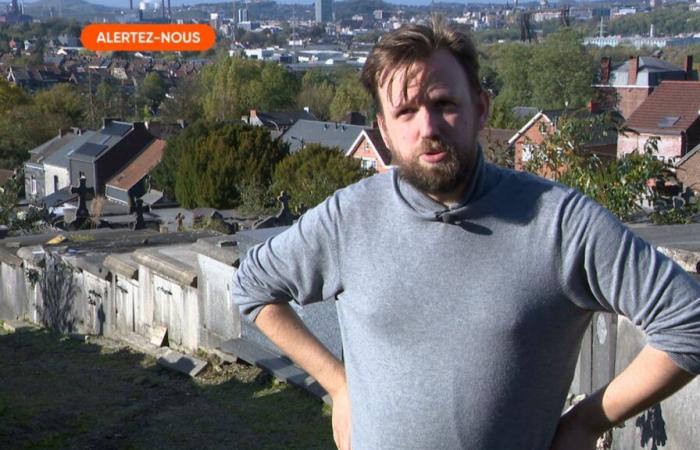
“When we see the state of the paths and the tombs… It’s scandalous,” he blurted out, deploring in particular graves covered with tarpaulins or simple wooden planks.
This is not an abandoned cemetery.
Faced with this complaint, Mahmut Dogru, alderman in charge of cemeteries in Charleroi, points out, among other things, the responsibility of the families of the deceased. “It is not an abandoned cemetery. If this cemetery is in this state, it is because the families, the rights holders no longer maintain the graves which are in the cemetery. Or quite simply because it there is no longer a beneficiary who must take care of the graves.”
However, the alderman recognizes that the ban on herbicides complicates the maintenance of cemeteries. “To say that everything is perfect would not be the truth. With the ban on the use of glyphosates, we have a lot of problems maintaining cemeteries. You should know that in Charleroi, we have 80 hectares of cemetery. It’s not an easy thing, but we’re working hard to get something decent.”
Mahmut Dogru also explains that the municipality plans to transform the Couillet cemetery into a “cemetery park”. “We have greatly limited the number of burials in this cemetery, due to its geographical position. It is a plot of land that is very steep. And with climate change and heavy rains, we fear for the stability of this “In the long term, we would like to stop burials in this cemetery.” he indicates.
The local elected official specifies that this Couillet cemetery is part of a global plan for the redevelopment of Charleroi cemeteries. In progress for several years, this project includes a vast exhumation program to free up green spaces in abandoned plots. “In recent years, we have put things in order, and any graves that are not maintained or are falling into ruin must be removed to have a better vision of the cemeteries. We launched the 2020-2050 cemetery plan, and We are in the process of carrying out major exhumations. You should know that since the start of my mandate, we have carried out more than 9,000 exhumations.he specifies.
“The objective is to recover the plots where the graves are abandoned and to make them green spaces to reduce the maintenance of the plots which no longer have rights. The aim is thus to have much better cemeteries maintained, rather than cemeteries where graves are left abandoned. In Charleroi, there are many graves to be removed, because there are no longer any families who take care of them or maintain them.
In certain municipalities, the maintenance of cemeteries poses big problems
For his part, Xavier Deflorenne, coordinator of the funerary heritage management unit at the Public Service of Wallonia (SPW), is not surprised by the state of certain Walloon cemeteries. “It doesn’t surprise me at all that citizens feel unequal depending on the municipality,” he concedes.
The burden of managing cemeteries is greater for municipalities with numerous sites to maintain. “It is known that in certain municipalities, the maintenance of cemeteries poses big problems. Different themes will appear depending on the municipalities you approach. Some will tell you, ‘since it is forbidden to use phytosanitary products, to spray in cemeteries, maintenance is much more complicated. This is a false argument, since since 2015, municipalities have been taught to revegetate the sites.
Xavier Deflorenne reminds us that municipal responsibility is not simply limited to the maintenance of paths. “In a cemetery, maintenance is twofold. On the one hand, the municipality has an obligation to maintain in particular the paths and the plots between the tombs of monuments. As for the monuments, that is to say locations allocated to families, it is the families who are responsible for monitoring the maintenance of the monuments”, he recalls.
And to add: “The municipality has an obligation to monitor maintenance. It must monitor how families maintain their own site. But families have a real responsibility. If the cemetery is poorly maintained on the paths, between the graves… It’s It is the municipality which is fully responsible If these are private sites, which have weeds, or monuments which fall over, it is the family which is to blame. But the municipality has a responsibility to display them. families ‘You are obliged to react’.”
“A cemetery remains the calling card of municipal management”, concludes Xavier Deflorenne.
A green cemetery is much nicer
Since the ban on pesticides and herbicides, municipal cemeteries are gradually being transformed under the influence of new ecological practices.
Philippe Fudala, eco-advisor for Cyréo (a social cooperative), explains: “The municipalities call on us for support and help with the maintenance of their cemeteries, whether preventatively by grassing the spaces or curatively by treating the spontaneous shoots that appear.”
Interventions have been more regular since the use of pesticides and herbicides was banned, passing “from two visits per year to a minimum of eight”, specifies Philippe Fudala.
“It represents a greater cost, but the advantage is that the cemeteries are much more beautiful. Generally speaking, a green cemetery is much more pleasant,” believes the eco-advisor.
“For our part, we try to respect the specifications of the municipalities. Some of them have aimed at revegetation. In this context, we manage the mowing and maintenance of the flowerbeds. Sometimes, the municipalities decide to keep their mineralized cemetery. At that time, we clear the bushes and weed. We ensure that the cemeteries remain clean and maintained areas. Some municipalities are behind schedule, and call us as a last resort. feel that they are unable to take over spontaneous vegetation. Others are more preventive by having control over this vegetation.
“Some municipalities are lagging behind, but this is not necessarily due to their inability to manage it,” says Philippe Fudala. “It is also due to the fact that the rights holders are not yet respectful of cemeteries. We must make them aware of the ecological maintenance of a grave.”





